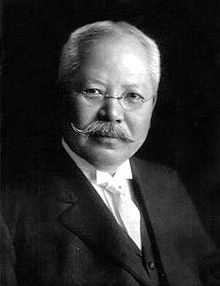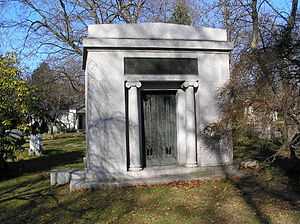Jokichi Takamine
| Jōkichi Takamine | |
|---|---|
 | |
| Born |
November 3, 1854 Takaoka, Toyama, Japan |
| Died |
July 22, 1922 New York, US |
| Fields | chemistry |
| Alma mater | University of Tokyo |
| Known for |
isolating and purifying adrenaline, isolating Takadiastase |
Jōkichi Takamine (高峰 譲吉 Takamine Jōkichi, November 3, 1854 – July 22, 1922) was a Japanese chemist.[1]
Early life and education
Takamine was born in Takaoka, Toyama Prefecture, in November 1854. [2] His father was a doctor; his mother a member of a family of sake brewers. He spent his childhood in Kanazawa, capital of present-day Ishikawa Prefecture in central Honshū, and was educated in Osaka, Kyoto, and Tokyo, graduating from the Tokyo Imperial University in 1879. He did postgraduate work at University of Glasgow and Anderson College in Scotland. He returned to Japan in 1883 and joined the division of chemistry at the Department of Agriculture and Commerce. He learned English as a child from a Dutch family in Nagasaki and so always spoke English with a Dutch accent.
Career
Japan
Takamine continued to work for the department of agriculture and commerce until 1887. He then founded the Tokyo Artificial Fertilizer Company, where he later isolated the enzyme takadiastase, an enzyme that catalyzes the breakdown of starch. Takamine developed his diastase from koji, a fungus used in the manufacture of soy sauce and miso. Its Latin name is Aspergillus oryzae, and it is a "designated national fungus" (kokkin) in Japan.[3]
In 1899, Takamine was awarded an honorary Doctorate in Engineering by what is now the University of Tokyo.[3]
United States
Takamine went as co-commissioner of the Cotton Exposition to New Orleans in 1884, where he met Lafcadio Hearn and Caroline Hitch, his future wife. He later emigrated to the United States and established his own research laboratory in New York City but licensed the exclusive production rights for Takadiastase to one of the largest US pharmaceutical companies, Parke Davis.[4] This turned out to be a shrewd move - he became a millionaire in a relatively short time and by the early 20th century was estimated to be worth $30 million.[3]
In 1901 he isolated and purified the hormone adrenaline (the first effective bronchodilator for asthma) from animal glands, becoming the first to accomplish this for a glandular hormone.[1][5]
In 1905 he founded the Nippon Club, which was for many years located at 161 West 93rd Street in Manhattan.[6]

Many of the beautiful cherry blossom trees in the West Potomac Park surrounding the Tidal Basin in Washington, D.C. were donated by the mayor of Tokyo, Yukio Ozaki and Dr. Takamine in 1912.[7]
In 1904, the Emperor Meiji of Japan honored Takamine with an unusual gift. In the context of the St. Louis World Fair (Louisiana Purchase Exposition), the Japanese government had replicated a historical Japanese structure, the "Pine and Maple Palace" (Shofu-den), modelled after the Kyoto Imperial Coronation Palace of 1,300 years ago. This structure was given to Dr. Takamine in grateful recognition of his efforts to further friendly relations between Japan and the United States.[8] He had the structure transported in sections from Missouri to his summer home in upstate New York, seventy-five miles north of New York City. In 1909, the structure served as a guest house for Prince Kuni Kuniyoshi and Princess Kuni of Japan, who were visiting the area.[9] Although the property was sold in 1922, the reconstructed structure remained in its serene setting. In 2008, it still continues to be one of the undervalued tourist attractions of New York's Sullivan County.[10]
The Takamine home in Kanazawa can still be seen today. It was relocated near the grounds of Kanazawa Castle in 2001.[11]
See also
References
- ↑ 1.0 1.1 Yamashima T (2003). "Jokichi Takamine (1854-1922), the samurai chemist, and his work on adrenalin". J Med Biogr 11 (2): 95–102. PMID 12717538.
- ↑ Shurtleff, W.; Aoyagi, A. 2012. "Jokichi Takamine (1854-1922) and Caroline Takamine (1866-1954): Biography and Bibliography." Lafayette, California: Soyinfo Center. 261 p. (601 references; 114 photos and illustrations. Free online).
- ↑ 3.0 3.1 3.2 Pulvers, Roger, "Jokichi Takamine: a man with fire in his belly whatever the odds", Japan Times, June 28, 2009, p. 8.
- ↑ Odagiri, Hiroyuki (1996). Technology and Industrial Development in Japan. Clarendon Press, Oxford. p. 214. ISBN 0-19-828802-6.
- ↑ Bennett M (1999). "One hundred years of adrenaline: the discovery of autoreceptors". Clin Auton Res 9 (3): 145–59. doi:10.1007/BF02281628. PMID 10454061.
- ↑ Gray, Christopher. "Streetscapes/161 West 93rd Street; A Building That Recalls the Days After Pearl Harbor," New York Times. September 30, 2001.
- ↑ "Cherry Trees in Washington DC".
- ↑ Estrow, Milton. "Japanese Palace; Replica Near Monticello Now Open to Public," New York Times. September 28, 1947.
- ↑ "Kuni in Japanese House; Host of Prince, Dr. Takamine, Has Japanese Structures of St. Louis Fair," New York Times. September 20, 1909.
- ↑ Shofu-den history
- ↑ 旧高峰家. "City Kanazawa Official Web Site." Accessed 15 July 2009. (Japanese)
References
- Biographical snapshots: Jokichi Takamine, Journal of Chemical Education web site.
- Hajime Hoshi. (1904). Handbook of Japan and Japanese Exhibits at World's Fair, St. Louis, 1904. St. Louis: Woodward and Tiernan Printing Co.. OCLC 12287183
Further reading
- Final Report of the Louisiana Purchase Exposition Commission: Japan's participation
External links
- Deerland Enzymes PDF (115 KiB) — Dr. Jokichi Takamine: Japanese father of American Biotechnology.
- Microbiological Process Report, L.A. Underkofler. et al., Takamine Laboratory PDF (1.88 MiB)— Production of Microbial Enzymes and Their Applications.
- History of Industrial Property Right, Jokichi Takamine Taka-Disatase, Adrenaline, Japan patent Office.
|